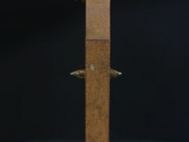Documentation of historical grand pianos of Klassik Stiftung Weimar
It was a great honour for us to be included in a so called KUR-Programm zur Konservierung und Restaurierung von mobilem Kulturgut (gefördert durch die Kulturstiftung des Bundes und die Kulturstiftung der Länder 2007-11) to be responsible for the documentation of some important instruments of Klassik Stiftung Weimar:
Grand piano by Sébastien Érard 1811/12
Grand piano by Nannette Stein-Streicher c1825
Grand piano by Jean Louis Boisselot 1846.
The Érard grand was bought for Weimar castle in turbulent times (after the Peace of Tilsit and before Napoleon's war against Russia) by Grand Duchess Maria Pavlovna as her own chamber music instrument.
Erard documents recorded a production date within the last days of 1811 but a delivery past New Year and thus a date 1812 on the instrument. This was later altered to 1802 by hand to make it appear a used instead of a new instrument probably to avoid whatever (customs?/tax?) issues during delivery,
The Streicher grand is closely linked to Johann
Nepomuk Hummel and the musicians of the Weimar court orchestra, in particular the musicians' family Eberwein.
The Boisselot grand was the concert instrument on Liszt's last tour 1846 who later used it for composing in his Weimar residence in the Altenburg.
These three instruments are important documents of the "golden" and "silver" eras of Weimar classicism and its musical culture. It may be assumed that Goethe heard musical concerts on the Érard as well as the Streicher grand. The music of Mozart and Beethoven in Hummel's interpretation on a Streicher instrument like this one may have influenced Goethe's ideas about music. The Boisselot grand served as a musical platform for Franz Liszt during one of the most productive periods in his life, as a tool of a piano culture formed by none other than himself. Thus these Weimar grands give impressive hints about technical elements, playing characteristics and the changing ideas of musical esthetics during the first half of the 19th century.
These three instruments from 1812, 1825 and 1846 reveal paradigmatic changes in ideas of piano sounds. They all have different actions: the Érard a pulling action (slightly modified by an unknown Weimar piano repairer during maintenance; see below left) invented in 1807, the Streicher a Viennese, the Boisselot an English action. This is as distant as imaginable from a uniform piano sound of our present times.
The Weimar grands project encompassed documentation by photographs and drawings by Helmut Balk as well as archival research by Prof. Dr. Franz Körndle and PD Dr. Erich Tremmel. This project, culminating in the Thüringer Landesausstellung 2011 "FRANZ LISZT - Ein Europäer in Weimar" is documented in several publications:
- Franz Körndle und Gert-Dieter Ulferts (Hrsg.): Konservierung und Restaurierung historischer Tasteninstrumente in den Sammlungen der Klassik Stiftung Weimar (Augsburg: Wißner-Verlag, 2011)
- Erich Tremmel und Gert-Dieter Ulferts (Hrsg.): Kosmos Klavier. Historische Tasteninstrumente der Klassik Stiftung Weimar (Augsburg: Wißner-Verlag, 2011)
- Detlef Altenburg (Hrsg.): FRANZ LISZT - Ein Europäer in Weimar; Katalog der gleichnamigen Thüringer Landesausstellung Weimar 24.6.-31.10.2011 (Köln: Verlag Walther König, 2011)
Pictures of Erard's grand action can give an impression of its complexity. The effect is not dissimilar to Erard's "double echappement" action in its different stages from 1821-40.
Top left shows Erard's drawing for the (denied) privilege of 1807. At some time in Weimar the beaks at the hammer axis were shortened (comp. below), obviously to change the touch and possibly speed of action. Next are a few samples of piano compositions dedidated to Grand Duchess Maria Pavlovna (her important personal collection of piano music today in Weimar Anna Amalia Bibliothek).












Details and parts of the Streicher Viennese action




The signature on Franz Liszt's Boisselot grand. 1844 is not the year of production!

A technical peculiarity of this grand, the iron strut below the soundboard, a rather ineffective means to counteract the string tension.

© Greifenberger Institut für Musikinstrumentenkunde | info@greifenberger-institut.de







